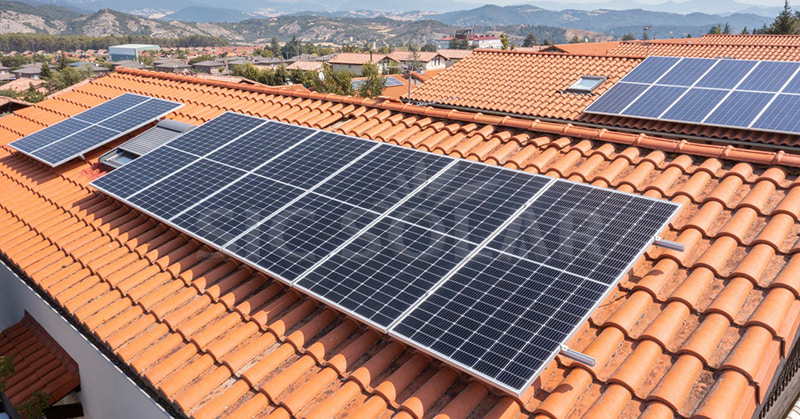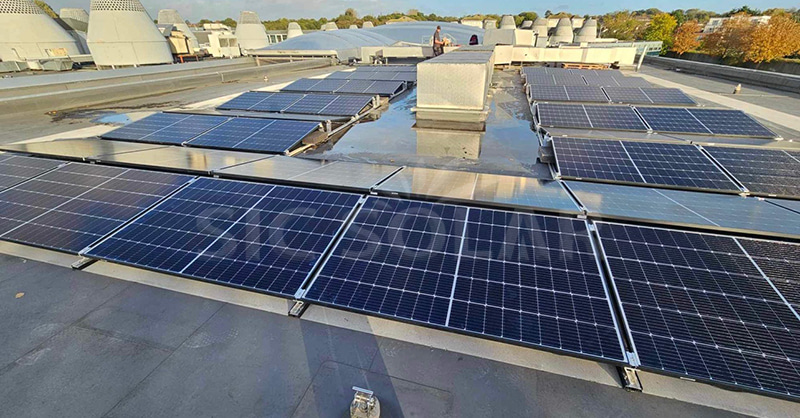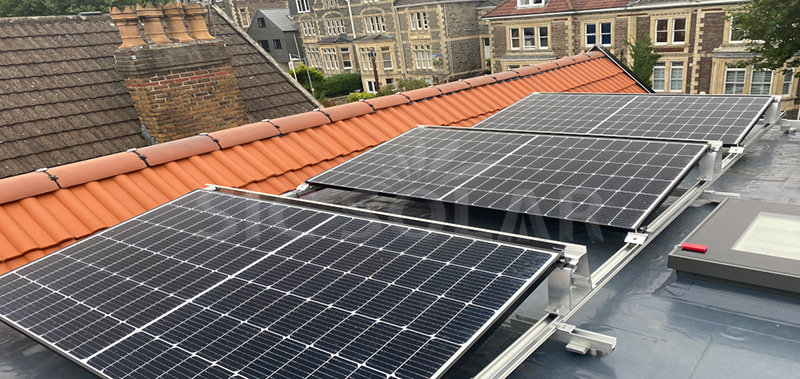-
|1.Roof Design and ComplexityPitched Roofs: Pitched roofs are angled, which means solar panels can be mounted at a natural tilt that allows them to capture sunlight more efficiently. The sloped design simplifies panel positioning, and the installation process typically requires fewer adjustments to the mounting system. Plus, pitched roofs are often made of materials like tiles, shingles, or metal, which provide secure anchor points for mounting brackets.1.Mounting SystemsPitched Roofs: The mounting systems for pitched roofs are generally simpler and more straightforward to install. SIC Solar offers robust and flexible mounting systems for pitched roofs, which include rail-based solutions that allow quick and efficient setup. The mounting hardware typically involves fewer components compared to flat roof systems, which can help reduce labor and material costs.2.Labor CostsPitched Roofs: Installing solar panels on a pitched roof can be easier and quicker, which can reduce labor costs. Since the angle of the roof already helps position the panels at an optimal tilt, the installation process is more straightforward. The presence of pre-existing anchor points in the roof structure, such as rafters, also makes mounting easier.3.Structural ConsiderationsPitched Roofs: Pitched roofs often require fewer structural reinforcements. The angle of the roof can distribute the weight of the solar panels more evenly, and the mounting brackets can be directly secured to the roof trusses, which generally provides sufficient structural support.4.Roof SpacePitched Roofs: Pitched roofs are typically smaller and can limit the number of panels that can be installed. However, the slope of the roof helps optimize panel orientation for maximum sunlight exposure, which can offset the smaller available space.
-
Does the flat roof installation system require additional reinforcement?
|When considering solar panel installation on a flat roof, many property owners and businesses wonder whether the roof will need additional reinforcement to support the weight of the panels and mounting system. Given that flat roofs are structurally different from pitched roofs, it’s important to understand how the installation of solar panels might impact the roof and whether any modifications are necessary.
Understanding Flat Roofs and Solar Installations
Flat roofs are commonly used in commercial and industrial buildings, as well as some residential properties. Their structure typically involves a slight pitch (less than 10 degrees) to allow water runoff, but they are generally more level than pitched roofs. This design can present unique challenges when installing solar panels, which require a stable foundation for optimal energy production.
Solar panel systems on flat roofs are typically mounted using ballasted systems or penetrating systems. Each of these systems has different considerations when it comes to reinforcing the roof.
1. Ballasted Systems: No Penetration, But Still Requires Stability
A ballasted mounting system is one in which the solar panels are secured to the roof using weighted materials, such as concrete blocks, to hold the panels in place. This type of system is ideal for roofs that cannot be penetrated, such as certain types of membrane or rubberized roofing.
Does a ballasted system require reinforcement?
- Yes, but not structural reinforcement in the traditional sense.
- The weight of the ballasted system itself can put additional stress on the roof, especially in areas with heavy snowfall or high winds. As a result, you may need to assess the load-bearing capacity of the roof to ensure it can support the weight of both the panels and the ballast.
- In some cases, consulting with a structural engineer may be necessary to determine if the roof’s existing structure is sufficient or if additional support, such as strengthening beams or adding extra ballast, is required.
SIC Solar ballasted mounting systems are designed to be lightweight yet sturdy, reducing the need for excessive weights and making the installation process more efficient while still providing reliable support for the solar panels.
2. Penetrating Systems: Secure but Require Roof Reinforcement
A penetrating mounting system involves anchoring the solar panel mounts directly into the roof structure, typically through the roofing material into the underlying structure (e.g., beams or trusses). This system is often preferred for its stability and reliability, as it provides a direct, secure connection to the roof.
Does a penetrating system require reinforcement?
- In many cases, yes.
- Because the mounting hardware must be anchored into the roof’s structure, it’s crucial to evaluate the structural integrity of the roof. If the roof is old, weakened, or lacks the proper load distribution, additional reinforcement may be required to prevent damage.
- Depending on the roof’s condition, you may need to add support beams, increase truss capacity, or strengthen areas that will bear the load of the solar panels.
SIC Solar penetrating mounting systems are designed with high-quality materials to minimize roof penetration and ensure that the panels are securely fastened. With careful planning and installation, these systems can be used on flat roofs without compromising the roof structure.
3. Factors Affecting Reinforcement Needs
Several factors should be considered when deciding whether a flat roof requires reinforcement for solar panel installation:
A. Roof Age and Condition
- Older roofs may require more careful inspection, as they may not have the structural integrity to support additional weight without reinforcement.
- Roofs that are damaged, sagging, or poorly maintained may need repairs before installing solar panels to ensure their long-term stability.
B. Roof Material
- Some roofing materials (e.g., membrane, bitumen) may be more sensitive to weight and penetration than others (e.g., concrete or metal). If your roof is made of a less durable material, you might need to reinforce it before proceeding with installation.
- Additionally, the type of roof membrane used may affect the type of mounting system you can use. If the roof material is prone to leaks, a ballasted system may be a better option since it doesn't require roof penetrations.
C. Local Climate and Weather Conditions
- The local climate, particularly factors like wind speeds, snow loads, and rainfall, can influence the type of reinforcement required. In areas with high winds, a penetrating system may require stronger anchors, while regions with heavy snowfall may require additional ballast to keep the panels secure.
D. Solar System Size and Weight
- The size and weight of the solar panel system will also play a role in determining whether additional reinforcement is needed. Larger systems with more panels or heavy-duty racking systems will place more weight on the roof, potentially requiring reinforcement.
How SIC Solar Mounting Systems Simplify Flat Roof Installations
SIC Solar designs mounting solutions that are specifically engineered to maximize performance while reducing the need for additional reinforcement. Here’s how their systems help:
-
Optimized for Weight Distribution: SIC Solar systems are designed to distribute the weight evenly, whether you’re using a ballasted or penetrating system, reducing the likelihood of stress on any single part of the roof structure.
-
Compatibility with Various Roof Types: Whether your roof is made of rubber, membrane, or metal, SIC Solar mounting systems are compatible with a wide range of materials, ensuring secure installations without compromising roof integrity.
-
Customizable Solutions: SIC Solar offers flexible mounting solutions that can be adapted to fit the specific needs of your project. Whether you need additional reinforcement or a lightweight system, they can tailor their products to suit your roof’s requirements.
-
Seamless Integration with Solar Panels: Their mounting systems are designed to integrate easily with solar panels, ensuring a secure, long-lasting installation with minimal risk of damage to your roof.


